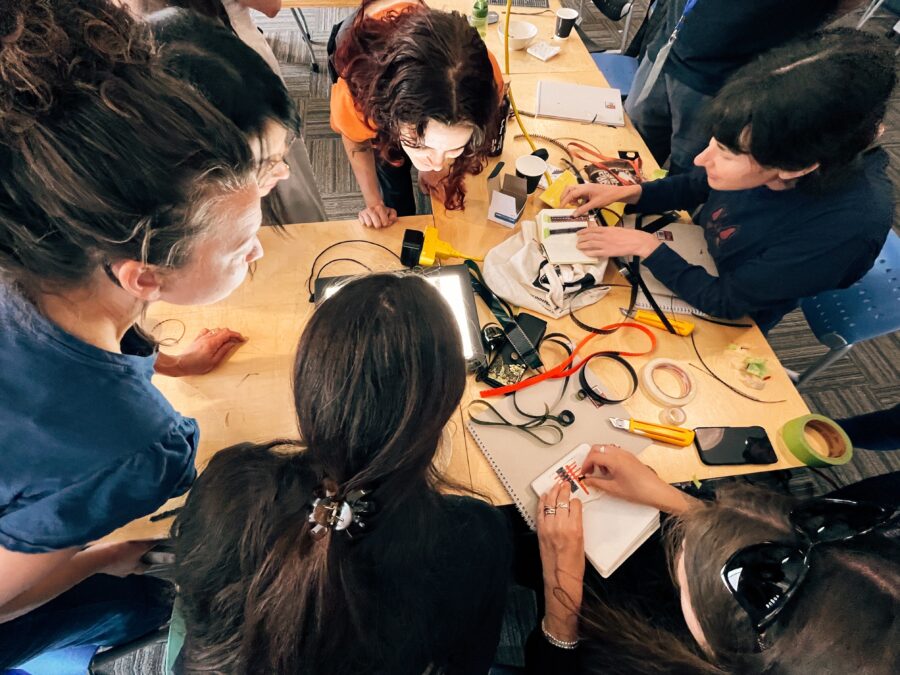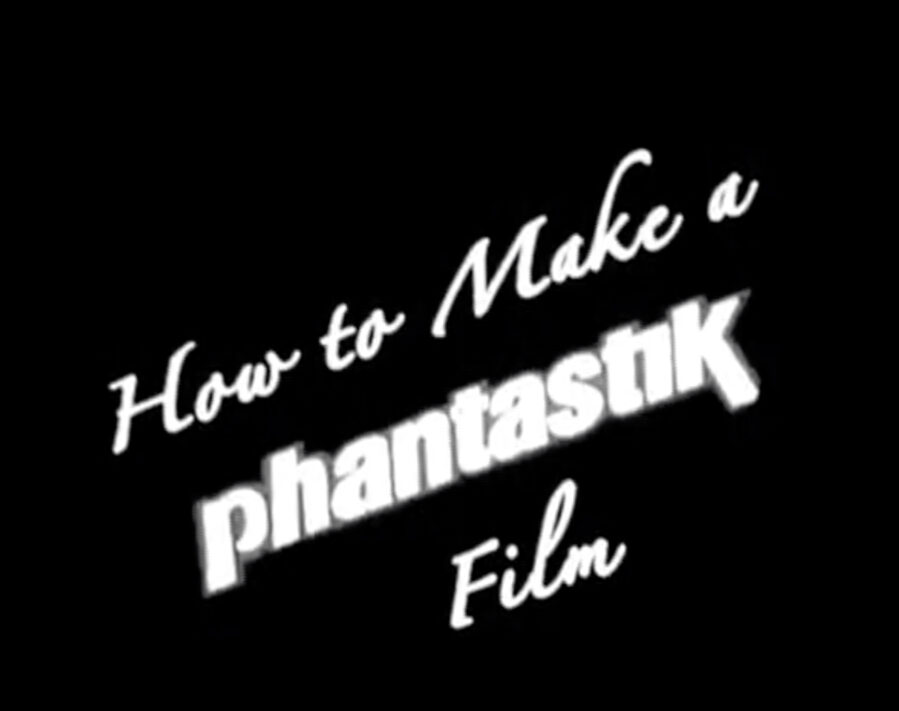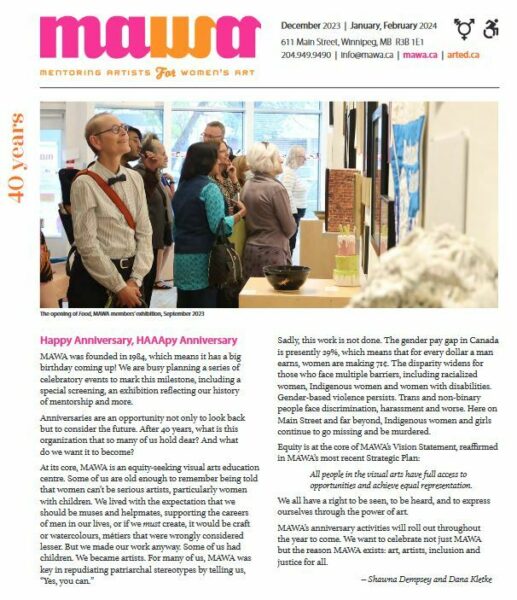
Participants at a direct animation workshop facilitated by Rhayne Vermette, Tkaronto/Toronto, 2023. Photo by Francisca Duran
In 2003, Lindsay McIntyre, an experimental filmmaker, conducted extensive experiments to discover that the household product Fantastik held the key to delicately removing emulsion from film while preserving the images for potential reapplication onto different surfaces. When she revealed her breakthrough, several men in the experimental film community claimed, “Oh, we already knew that was the secret,” despite having previously withheld this information from McIntyre for the one and a half years during which she sought it. In response to this knowledge hoarding, McIntyre took a stand by creating and freely distributing How to Make a Phantastik Film, a film that openly shares the technique with the audience.

Lindsay McIntyre, How to Make a Phantastik Film (still), 2003
In a recent collaborative text I wrote with McIntyre exploring the art-facilitation endeavours of Francisca Duran, we asserted, “New worlds are born through invitations.”(i) I aim to expand upon this notion, contending that invitations, while crucial, often prove insufficient; what we truly require is a trusted companion willing to traverse the threshold alongside us. Artists including McIntyre, Duran and Rhayne Vermette foster collaborative learning by navigating the journey beside us, deliberately dismantling the façade of hierarchical perfection and debunking myths that perpetuate a sense of inaccessibility.
Duran orchestrates sessions where she not only invites you to learn the photographic phytogram technique but engages in the process alongside you. Having witnessed these workshops, I have observed participants seamlessly transitioning from learning the technique to teaching others within the same session. The shared celebration of the creative process, prioritizing it over the final product, dissolves barriers of intimidation. Duran challenges the notion of exclusive ownership of artwork by actively promoting collaboration between humans with plant life and with chance. In the exhibition of her works, she invites viewers into the creative process, conducting workshops to reveal the techniques behind her creations. For instance, the poster for her recent exhibition Research garden: a compendium of lost moments serves as a recipe card, compiling a series of eco-photochemical recipes employed in creating the artwork alongside acknowledgements of contributors/collaborators, highlighting the myriad elements that come together to make an exhibition possible.

Francisca Duran and participants working side-by-side on the collaborative 100-ft phytogram (owned by all, owned by none), Mnisiing/Toronto Islands, 2023. Photo by katnancy
Recently I have been having conversations with others in the media arts regarding filmmaking hierarchy. In a conversation with Charlene Raven Moore, we pondered ways in which the notion of a sole film “director” who traditionally “rules” could be subverted and found examples in women experimental creators. For example, on set McIntyre and Vermette dismantle the idea of themselves as unquestionable forces. When communicating with her cast and crew, Vermette emphasizes that “We're all learning.” Both McIntyre and Vermette dedicate themselves to nurturing their communities, providing countless filmmakers with first-time experiences. Demonstrating a belief in others fosters reciprocal success. McIntyre and Vermette fumble along beside us, revealing their imperfect practices and ever-ongoing learning, showing us that we too can create imperfectly while learning and teaching. In her workshops, Vermette asserts “No secrets!” and emphasizes the open sharing of techniques without fear of scarcity or competition. There is a collective acknowledgment of individual, unique powers, celebrated both within oneself and among peers.
In 2022, Colour Reversal, a BIPOC Analogue Film Incubator, took place in Regina, facilitated by Vermette, McIntyre and Hagere Selam “shimby” Zegeye-Gebrehiwot. In a follow-up version of this event, held in Winnipeg at WNDX Festival of Moving Image, McIntyre reflected on the historically cis-white-male dominated culture of opacity, hoarding and scarcity she had had to face and push through at the beginning of her career. She gestured around the room and said, “I wish I'd had something like this. This is a dream.” We are at a juncture where these once chimerical dreams are becoming lived realities, where new worlds are being born of intricate communities ready to collectively hold them. And we are at the juncture between these being brief, project-based bursts of life we only wish we could sustain, and the sustained light of consistent, mosaic practices intertwined.
We have reached this moment because women like McIntyre, Duran and Vermette persist against the odds, dismantling ideas of scarcity and cultivating environments of abundance. They freely share their knowledge, serving as examples for those they hold space for. Everyone they teach comes away with a gift—a profound sense of responsibility to teach and open space onward.
These practitioners do not wait for validation from social systems to tell them they are qualified teachers. Climbing preconceived ladders of success toward a distant moment when someone taps you on the shoulder to anoint you for the hierarchical role of “mentor” or “teacher” is how large knowledge banks end up disappearing from collective access. Information gets stale while hoarded away, and people die holding it. We need to be teaching as we go, further growing our own skills. We learn so much about ourselves and the ways we work by being curiously questioned by those who are learning from us. These grass-roots, transgenerational networks based on reciprocity and gift economies transcend the historically perceived need for validation from dominant systems. Through them, we support each other, respond to ever-evolving needs, and foster in-built succession.
___
For and with Lindsay McIntyre, Francisca Duran, Rhayne Vermette, Charlene Raven Moore, Cecilia Araneda (whose curation/administration work directly and indirectly linked us all together), Heidi Phillips (whose early conversations with Amalie Atkins and Rhayne Vermette birthed what was to become Colour Reversal) and so many more. As Bonnie Raitt sings: “Thank you, baby, for giving me my life,”
(i) Lindsay McIntyre & katnancy, like a fire we gather round: Phytograms, Ecologies, and Multivocal Agency (forthcoming 2024)
katnancy (they/she) is a collaborator, writer and experimental media artist-curator committed to art as a tool of education and empowerment, with a focus on how photo(light) processes reveal the constructed, manipulative nature of representation, perception, value and power.

